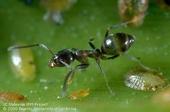
Download the free booklet at the bottom of the page!
1. Ants
Most people deal with ants around their home at some point. Because most ants live outdoors, focus efforts on keeping ants from entering buildings by caulking entryways. Follow good sanitation practices to make your home less attractive to ants. Spraying ants inside the home will not prevent more ants from entering. Use baits to control the ant colony. Pesticide baits work by attracting worker ants who then take the poison back to the nest where the entire colony, including queens, can be killed. In the landscape, ants protect...
- Author: Elizabeth E Grafton-Cardwell
- Author: Matthew Daugherty
- Author: Cheryl A. Wilen
![Figure 1. Highly magnified adult Asian citrus psyllid feeding on citrus. [B. Grafton-Cardwell]](https://ucanr.edu/blogs/UCIPMurbanpests/blogfiles/35982small.jpg)
[From the March 2016 issue of UC IPM's Retail Nursery & Garden Center IPM News]
Asian citrus psyllid (ACP) continues to spread and to be an ever-present concern in California. Because of this, we have updated information from the April 2015 issue of UC IPM's Retail IPM newsletter to share with your customers.
Until 2013, ACP was mostly found in Southern California, but has since been found in multiple locations in the Central Valley and has been detected as far north as the San Francisco Bay Area. The psyllid is well-established in coastal and inland Southern California and it is slowly establishing itself in...
- Author: Anne Schellman
- Author: Karey Windbiel Rojas
![Pesticides on store shelves. [A. Schellman]](https://ucanr.edu/blogs/UCIPMurbanpests/blogfiles/35337small.jpg)
Gardeners and other consumers frequently look to retail nursery and garden center employees to answer questions about pests and pesticides. To help retailers stay abreast of current pest topics facing California, UC IPM held a workshop for retail employees on January 28, 2016 in Ontario, CA focusing on integrated pest management (IPM) concepts and current issues. Partnering with local UC Cooperative Extension (UCCE) Advisors and Specialists, the day was filled with information participants could bring back to customers to address their pest and plant problems.
Topics addressed in these workshops include:
- Invasive Pests
- Asian citrus psyllid and...
- Author: Jeannette E. Warnert

From the UCANR Green Blog
A tell-tale sign of spring in California is a flush of new leaf growth on citrus trees. Because the feathery light green leaves are particularly attractive to Asian citrus psyllids (ACP), the leaves' emergence marks a critical time to determine whether the pest has infested trees.
“We encourage home citrus growers and farmers to go out with a magnifying glass or hand lens and look closely at the new growth,” said Beth Grafton-Cardwell, UC Agriculture and...
![Citrus fruit. [J.K. Clark]](https://ucanr.edu/blogs/UCIPMurbanpests/blogfiles/34471small.jpg)
News release from the California Department of Food and Agriculture (CDFA)
February 3, 2016 - Two additional trees in San Gabriel have tested positive for Huanglongbing. The two trees, an orange and a kumquat, are on separate properties but are both within the core area in San Gabriel where 10 diseased trees were confirmed last summer. Given the close proximity, there will not be a quarantine expansion.
One of the HLB-positive trees has already been removed and California Department of Food and Agriculture officials are in the process of contacting the other homeowner to schedule tree removal. Agriculture officials are working quickly in the area.


